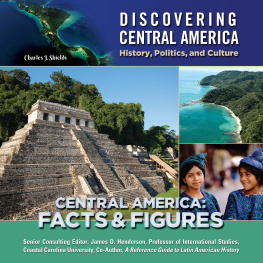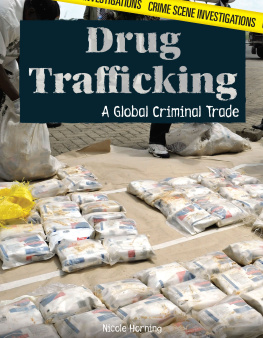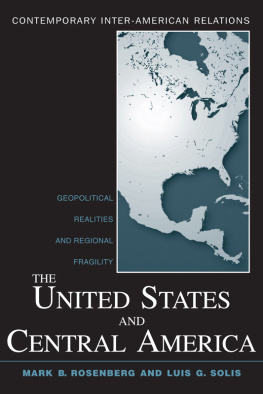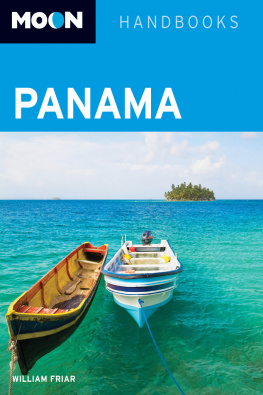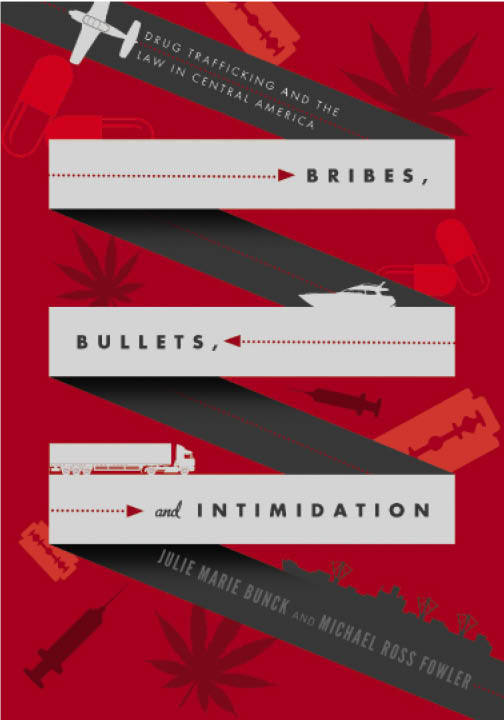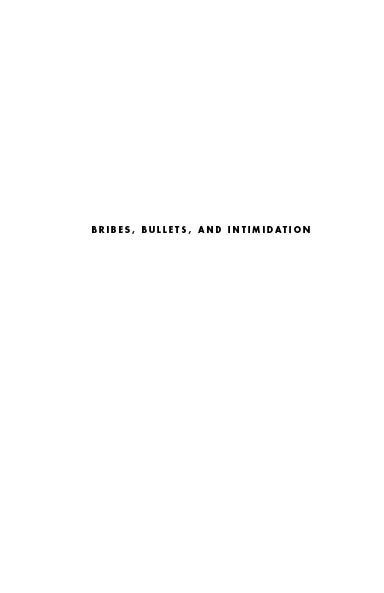
Cover spot Shutterstock
Library of Congress Cataloging-in-Publication Data
Bunck, Julie Marie, 1960
Bribes, bullets, and intimidation : drug trafficking and
the law in central america / Julie Marie Bunck and
Michael Ross Fowler
p. cm.
Includes bibliographical references and index.
Summary: Examines drug trafficking through Central
America and the efforts of law enforcement to counter it.
Details the routes, methods, and networks involved, while
comparing the evolution of the drug trade in Belize, Costa
Rica, Guatemala, Honduras, and Panama over three
decadesProvided by publisher.
isbn 978-0-271-04866-6 (cloth : alk. paper)
1. Drug trafficLatin AmericaCase studies.
2. Drug controlLatin AmericaCase studies.
I. Fowler, Michael Ross.
II. Title.
HV5840.L3B86 2012
363.4509728dc23
2011045324
Copyright 2012 The Pennsylvania State University
All rights reserved
Printed in the United States of America
Published by The Pennsylvania State University Press,
University Park, PA 16802-1003
The Pennsylvania State University Press is a member of
the Association of American University Presses.
It is the policy of The Pennsylvania State University Press
to use acid-free paper. Publications on uncoated stock
satisfy the minimum requirements of American National
Standard for Information SciencesPermanence of
Paper for Printed Library Material, ansi z 39.48-1992.
This book is printed on Natures Natural, which contains
50% post-consumer waste.
CONTENTS
List of Illustrations /
Acknowledgments /
List of Abbreviations /
Introduction: Exploring Central American Drug Trafficking /
Central America and the International Trade in Drugs /
Belize /
Costa Rica /
Guatemala /
Honduras /
Panama /
Conclusion /
Selected Bibliography /
Index of Cases /
Index of Names /
General Index /
ILLUSTRATIONS
FIGURES
1.1 Cultivation of opium in Colombia and Mexico, 19912009
1.2 Projected heroin production in Colombia and Mexico, 19952009
1.3 Heroin seizures in key Central American bridge states, 19911999
1.4 Heroin seizures in key Central American bridge states, 20002010
1.5 Cocaine seizures in key Central American bridge states, 19901999
1.6 Cocaine seizures in key Central American bridge states, 20002010
1.7 Estimated marijuana users in the United States, 19792009
1.8 Estimated heroin users in the United States, 19792009
1.9 Estimated cocaine users in the United States, 19792009
2.1 Marijuana production in Belize, 19821990
2.2 Marijuana yield and exports from Belize, 19821990
2.3 Cocaine seizures in Belize, 19902010
3.1 Marijuana cultivation, eradication, and yield in Costa Rica, 19851991
3.2 Eradication of marijuana plants in Costa Rica, 19922010
3.3 Costa Rican seizures of cocaine, 19821995
3.4 Costa Rican seizures of cocaine, 19962010
3.5 Costa Rican seizures of heroin, 19922009
4.1 Net production of opium in Guatemala, 19851995
4.2 Cocaine seizures in Guatemala, 19872010
5.1 Cocaine seizures in Honduras, 19861995
5.2 Cocaine seizures in Honduras, 19962010
6.1 Marijuana seizures in Panama, 19821995
6.2 Marijuana seizures in Panama, 19962009
6.3 Heroin seizures in Panama, 19922009
6.4 Cocaine seizures in Panama, 19821995
6.5 Cocaine seizures in Panama, 19962010
MAPS
1.1 Central America and areas north
1.2 Colombia
1.3 Mexico
2.1 Belize
3.1 Costa Rica
4.1 Guatemala
5.1 Honduras
6.1 Panama
TABLES
5.1 Major seizures of Honduran vessels carrying marijuana, 19801990
6.1 Cocaine seizures of more than one ton involving the Coln Free Zone
ACKNOWLEDGMENTS
This book is the product of many years spent studying the international drug trade in Central America. As we canvassed court records and newspaper accounts and spoke to scores of public officials and others, we amassed considerable debts to many helpful individuals. Those cited by name represent a small fraction of all who gave generously of their time in helping us with our research. We appreciate all the help received, and naturally, no one who assisted us bears any responsibility for the content of this study.
Given how little was known about the bridge-state drug trade and given the secrecy of trafficking activities and certain of the law-enforcement efforts to counter them, few at first believed that this was a viable research project. We would thus like to extend special thanks to Kenneth W. Thompson and the Institute for the Study of World Politics (ISWP) in Washington, D.C., for recognizing the gap in the drug literature that this work might fill, for believing in our ability to bring the project to fruition over the long term, and for providing us with our initial research grant. The Institute of Foreign Policy Analysis at Tufts University then ably administered our ISWP start-up grant. We also specially thank those who read the manuscript, or portions of it, and offered their suggestions on improvements. Along with a number of anonymous reviewers, two retired professors, William O. Walker III of the University of Toronto and Inis L. Claude Jr. of the University of Virginia, offered extremely valuable and greatly appreciated advice.
We also owe much to the generosity of the Council for the International Exchange of Scholars. That organization, through its Fulbright Scholarship Central American Republics Research Program, funded our second major research trip and later enabled us to lay the theoretical foundation for our work and to advance toward a finished product through awards to Japan and Mexico. The Miller Center of Public Affairs at the University of Virginia, the Department of Politics at Australias Bond University, and the Center for Social Research at Mexicos Universidad de Colima all provided forums for us to present our research and absorb suggestions and constructive criticisms, as did annual conferences of the Latin American Studies Association and the American Political Science Association. We thank our own University of Louisville for a Lewis Fellowship in Latin American Studies and a Project Completion Grant, as well as for its various Panama programs, which helped to finance multiple trips for fieldwork. The universitys Department of Political Science, its Brandeis School of Law, and its Muhammad Ali Institute also contributed talented and indefatigable research assistants, including Kevin Fahey, Mikkaka Hardaway, Amelie Quinnec, Chris Rueff, Abi Smith, Holly Wallace, and Ramsey Younis. And no one contributed more time and effort than Carolyn Morgan, whose work with our charts went far beyond the call of duty.
We would also like to thank the wide array of officials from the United States and the Central American republics who assisted one way or another in our research. In particular, the firsthand insights of those contending with the regional drug trade contributed much to our understanding. Without their cooperation, this work would have been much more limited in scope. For example, in Belize on several occasions the Office of the Chief Magistrate permitted us to undertake extensive reviews of court records. Similarly, in Costa Rica the archives of the Judicial Branch supplied opinions from dozens of the most significant drug cases, and the Judicial Branch Office of Statistics directed us to their relevant data on drugs. In Guatemala the Office of the Director of Prisons provided help in the review of public files on drug offenders, and the Office of Statistics of the Judicial Branch undertook a lengthy and informative project to compile statistics on a range of offenses, including various categories of drug cases. In Honduras persons associated with the Commission for the Reform of the Judicial System of Honduras and the Faculty of Law at the National Autonomous University gave freely of their time on repeated occasions, and the Office of the Director of the Penal Establishment allowed us access to personnel, statistics, and records. To supplement this information, Honduran Supreme Court archivists helped us to ferret out relevant information regarding drug-trafficking cases, convictions, and sentencing. In Panama the Solicitor-Generals Office and the Center for Juridic Investigation at the Faculty of Law, University of Panama, were singularly helpful in arranging interviews and helping us to find relevant information.


